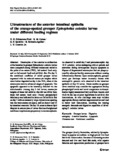Ultrastructure of the anterior intestinal epithelia of the orange-spotted grouper Epinephelus coioides larvae under different feeding regimes

View/
Request this document
Date
2014Page views
316Metadata
Show full item recordCited times in Scopus
Share
Abstract
Enterocytes of the anterior to midsection of the intestine in grouper Epinephelus coioides larvae were compared among different treatments: unfed to the point-of-no-return (PNR), fed natural food only, and co-fed natural food and artificial diet. On day 3, the nutritional condition of unfed grouper larvae regressed with its reduced enterocyte heights which were further degraded on day 4, the PNR, when all the enterocytes were in advanced stages of apoptosis. The apoptosis appeared to be internally directed via the mitochondria. Among day 3 fed larvae, enterocyte heights of those fed artificial diet did not differ from those fed natural food only. Dietary phospholipid deficiency was indicated in larvae co-fed artificial diet on day 3 with an unusually large chylomicron opening into the inter-enterocyte space, and on days 6 and 33 by intestinal steatosis. On day 19, scant to absent lipid droplets in enterocytes of larvae disclosed heightened nutritional requirement preparatory to metamorphosis. As observed in unfed day 3 and premetamorphic day 19 E. coioides, larvae undergoing critical periods and starvation during development employ apoptosis to dispose of degenerated enterocytes that are phagocytosed by adjacent healthy enterocytes without causing inflammatory distress. Upon metamorphosis, grouper larval gut develops better immunity fitness with eosinophilic granule cells observed in the intestinal epithelia of day 33 larvae. Future studies on grouper larval nutrition may consider the appropriate dietary phospholipid levels and larval competence to biosynthesize highly unsaturated fatty acid from linoleic acid vis-à-vis the use of plant ingredients in artificial diet formulations. In vivo challenge tests may validate appropriate dietary nutrient supplementation and lead to better feed formulation, matching the varying energetic demands and digestive capacities of developing E. coioides larvae.
Suggested Citation
Primavera-Tirol, Y. H., Coloso, R. M., Quinitio, G. F., Ordonio-Aguilar, R., & Laureta, L. V. , Jr. (2014). Ultrastructure of the anterior intestinal epithelia of the orange-spotted grouper Epinephelus coioides larvae under different feeding regimes. Fish Physiology and Biochemistry , 40(2), 607-624. https://doi.org/10.1007/s10695-013-9870-y
Subject
Collections
- AQD Journal Articles [1240]

